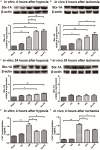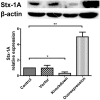Syntaxin 1A mediates isoflurane but not hypoxia preconditioning-induced alleviation of hypoxia-reoxygenation injury in rat cardiomyocytes
- PMID: 26692932
- PMCID: PMC4656765
Syntaxin 1A mediates isoflurane but not hypoxia preconditioning-induced alleviation of hypoxia-reoxygenation injury in rat cardiomyocytes
Abstract
Preconditioning with ischemia/hypoxia (IPC/HPC) or clinically available volatile anesthetics such as isoflurane (Iso-PC) could activate cardioprotective signaling pathways, thereby reducing myocardial ischemia/reperfusion (IR) injury. However, their molecular targets remain elusive. We herein investigated the roles of syntaxin 1A (Stx-1A) in cardiomyocyte protection induced by HPC and Iso-PC. Both in vivo myocardial IR model and in vitro cardiomyocyte hypoxia/reoxygenation (HR) model were used to test the effects of IR/HR, IPC/HPC and Iso-PC on Stx-1A protein expression. Stx-1A knockdown and overexpression in cardiomyocytes were achieved by adenovirus infection to define the relationship between Stx-1A levels and IPC/Iso-PC-induced cardioprotection. Cardiac troponin T (cTnT), cell apoptosis rate, and cell viability were introduced as indicators for cardiomyocyte HR injury. Changes of cardioprotective signaling pathways activities including PI3K/AKT/GSK3β, ERK1/2, STAT3 and PKC were also detected using Western blot. Rat cardiomyocyte Stx-1A was upregulated 4 hours after IR or HR. IPC/HPC as well as Iso-PC further increased Stx-1A expression compared with IR/HR. Stx-1A knockdown was accompanied with more cell apoptosis and decreased cell viability while overexpression of Stx-1A seemed cardioprotective. Iso-PC induced decrease in cell apoptosis and increase in cell viability but not HPC-induced cardioprotection was reversed by Stx-1A shRNA transfection. No difference in cell apoptosis or cell viability was found before and after Stx-1A overexpression in each group. Moreover, Stx-1A knockdown were accompanied with increased PI3K/AKT/GSK3β activities irrespective of the treatments. Stx-1A is cardioprotective and a potential target of isoflurane induced cardioprotection. Further studies are needed to test whether stx-1A is regulated by AKT/GSK3β signaling.
Keywords: Syntaxin 1A; cardiomyocyte; hypoxia; preconditioning; volatile anesthetics.
Figures






Similar articles
-
Activation of the nonneuronal cholinergic cardiac system by hypoxic preconditioning protects isolated adult cardiomyocytes from hypoxia/reoxygenation injury.Am J Physiol Heart Circ Physiol. 2024 Jul 1;327(1):H70-H79. doi: 10.1152/ajpheart.00211.2024. Epub 2024 May 3. Am J Physiol Heart Circ Physiol. 2024. PMID: 38700468 Free PMC article.
-
Hypoxic preconditioning protects cardiomyocytes against hypoxia/reoxygenation-induced cell apoptosis via sphingosine kinase 2 and FAK/AKT pathway.Exp Mol Pathol. 2016 Feb;100(1):51-8. doi: 10.1016/j.yexmp.2015.11.025. Epub 2015 Nov 24. Exp Mol Pathol. 2016. PMID: 26621495
-
The cardioprotective effect of hypoxic and ischemic preconditioning in dogs with myocardial ischemia-reperfusion injury using a double-bypass model.Life Sci. 2015 Nov 15;141:25-31. doi: 10.1016/j.lfs.2015.09.002. Epub 2015 Sep 11. Life Sci. 2015. PMID: 26365363
-
Remifentanil Preconditioning Reduces Postischemic Myocardial Infarction and Improves Left Ventricular Performance via Activation of the Janus Activated Kinase-2/Signal Transducers and Activators of Transcription-3 Signal Pathway and Subsequent Inhibition of Glycogen Synthase Kinase-3β in Rats.Crit Care Med. 2016 Mar;44(3):e131-45. doi: 10.1097/CCM.0000000000001350. Crit Care Med. 2016. PMID: 26468894
-
Isoflurane preconditioning protects rat brain from ischemia reperfusion injury via up-regulating the HIF-1α expression through Akt/mTOR/s6K activation.Cell Mol Biol (Noisy-le-grand). 2016 Feb 29;62(2):38-44. Cell Mol Biol (Noisy-le-grand). 2016. PMID: 26950449
Cited by
-
SNARE-ing the Reason for Post-Cardiac Surgery Critical Illness-Related Corticosteroid Insufficiency.Genes (Basel). 2024 Jan 20;15(1):128. doi: 10.3390/genes15010128. Genes (Basel). 2024. PMID: 38275610 Free PMC article.
-
Activation of Endocannabinoid Receptor 2 as a Mechanism of Propofol Pretreatment-Induced Cardioprotection against Ischemia-Reperfusion Injury in Rats.Oxid Med Cell Longev. 2017;2017:2186383. doi: 10.1155/2017/2186383. Epub 2017 Jul 26. Oxid Med Cell Longev. 2017. PMID: 28814985 Free PMC article.
-
Dehydroepiandrosterone alleviates hypoxia-induced learning and memory dysfunction by maintaining synaptic homeostasis.CNS Neurosci Ther. 2022 Sep;28(9):1339-1350. doi: 10.1111/cns.13869. Epub 2022 Jun 15. CNS Neurosci Ther. 2022. PMID: 35703574 Free PMC article.
-
Proteomics-based investigation of cerebrovascular molecular mechanisms in cerebral amyloid angiopathy by the FFPE-LMD-PCT-SWATH method.Fluids Barriers CNS. 2022 Jul 1;19(1):56. doi: 10.1186/s12987-022-00351-x. Fluids Barriers CNS. 2022. PMID: 35778717 Free PMC article.
-
Hypoxic mitophagy regulates mitochondrial quality and platelet activation and determines severity of I/R heart injury.Elife. 2016 Dec 20;5:e21407. doi: 10.7554/eLife.21407. Elife. 2016. PMID: 27995894 Free PMC article.
References
-
- Wright DE, Hunt DP. Perioperative surveillance for adverse myocardial events. South Med J. 2008;101:52–58. - PubMed
-
- Botto F, Alonso-Coello P, Chan MT, Villar JC, Xavier D, Srinathan S, Guyatt G, Cruz P, Graham M, Wang CY, Berwanger O, Pearse RM, Biccard BM, Abraham V, Malaga G, Hillis GS, Rodseth RN, Cook D, Polanczyk CA, Szczeklik W, Sessler DI, Sheth T, Ackland GL, Leuwer M, Garg AX, Lemanach Y, Pettit S, Heels-Ansdell D, Luratibuse G, Walsh M, Sapsford R, Schünemann HJ, Kurz A, Thomas S, Mrkobrada M, Thabane L, Gerstein H, Paniagua P, Nagele P, Raina P, Yusuf S, Devereaux PJ, Devereaux PJ, Sessler DI, Walsh M, Guyatt G, McQueen MJ, Bhandari M, Cook D, Bosch J, Buckley N, Yusuf S, Chow CK, Hillis GS, Halliwell R, Li S, Lee VW, Mooney J, Polanczyk CA, Furtado MV, Berwanger O, Suzumura E, Santucci E, Leite K, Santo JA, Jardim CA, Cavalcanti AB, Guimaraes HP, Jacka MJ, Graham M, McAlister F, McMurtry S, Townsend D, Pannu N, Bagshaw S, Bessissow A, Bhandari M, Duceppe E, Eikelboom J, Ganame J, Hankinson J, Hill S, Jolly S, Lamy A, Ling E, Magloire P, Pare G, Reddy D, Szalay D, Tittley J, Weitz J, Whitlock R, Darvish-Kazim S, Debeer J, Kavsak P, Kearon C, Mizera R, O’Donnell M, McQueen M, Pinthus J, Ribas S, Simunovic M, Tandon V, Vanhelder T, Winemaker M, Gerstein H, McDonald S, O’Bryne P, Patel A, Paul J, Punthakee Z, Raymer K, Salehian O, Spencer F, Walter S, Worster A, Adili A, Clase C, Cook D, Crowther M, Douketis J, Gangji A, Jackson P, Lim W, Lovrics P, Mazzadi S, Orovan W, Rudkowski J, Soth M, Tiboni M, Acedillo R, Garg A, Hildebrand A, Lam N, Macneil D, Mrkobrada M, Roshanov PS, Srinathan SK, Ramsey C, John PS, Thorlacius L, Siddiqui FS, Grocott HP, McKay A, Lee TW, Amadeo R, Funk D, McDonald H, Zacharias J, Villar JC, Cortés OL, Chaparro MS, Vásquez S, Castañeda A, Ferreira S, Coriat P, Monneret D, Goarin JP, Esteve CI, Royer C, Daas G, Chan MT, Choi GY, Gin T, Lit LC, Xavier D, Sigamani A, Faruqui A, Dhanpal R, Almeida S, Cherian J, Furruqh S, Abraham V, Afzal L, George P, Mala S, Schünemann H, Muti P, Vizza E, Wang CY, Ong GS, Mansor M, Tan AS, Shariffuddin II, Vasanthan V, Hashim NH, Undok AW, Ki U, Lai HY, Ahmad WA, Razack AH, Malaga G, Valderrama-Victoria V, Loza-Herrera JD, De Los Angeles Lazo M, Rotta-Rotta A, Szczeklik W, Sokolowska B, Musial J, Gorka J, Iwaszczuk P, Kozka M, Chwala M, Raczek M, Mrowiecki T, Kaczmarek B, Biccard B, Cassimjee H, Gopalan D, Kisten T, Mugabi A, Naidoo P, Naidoo R, Rodseth R, Skinner D, Torborg A, Paniagua P, Urrutia G, Maestre ML, Santaló M, Gonzalez R, Font A, Martínez C, Pelaez X, De Antonio M, Villamor JM, García JA, Ferré MJ, Popova E, Alonso-Coello P, Garutti I, Cruz P, Fernández C, Palencia M, Díaz S, Del Castillo T, Varela A, de Miguel A, Muñoz M, Piñeiro P, Cusati G, Del Barrio M, Membrillo MJ, Orozco D, Reyes F, Sapsford RJ, Barth J, Scott J, Hall A, Howell S, Lobley M, Woods J, Howard S, Fletcher J, Dewhirst N, Williams C, Rushton A, Welters I, Leuwer M, Pearse R, Ackland G, Khan A, Niebrzegowska E, Benton S, Wragg A, Archbold A, Smith A, McAlees E, Ramballi C, Macdonald N, Januszewska M, Stephens R, Reyes A, Paredes LG, Sultan P, Cain D, Whittle J, Del Arroyo AG, Sessler DI, Kurz A, Sun Z, Finnegan PS, Egan C, Honar H, Shahinyan A, Panjasawatwong K, Fu AY, Wang S, Reineks E, Nagele P, Blood J, Kalin M, Gibson D, Wildes T Vascular events In noncardiac Surgery patIents cOhort evaluatioN (VISION) Writing Group, on behalf of The Vascular events In noncardiac Surgery patIents cOhort evaluatioN (VISION) Investigators; Appendix 1. The Vascular events In noncardiac Surgery patIents cOhort evaluatioN (VISION) Study Investigators Writing Group; Appendix 2. The Vascular events In noncardiac Surgery patIents cOhort evaluatioN Operations Committee; Vascular events In noncardiac Surgery patIents cOhort evaluatioN VISION Study Investigators. Myocardial injury after noncardiac surgery: a large, international, prospective cohort study establishing diagnostic criteria, characteristics, predictors, and 30-day outcomes. Anesthesiology. 2014;120:564–578. - PubMed
-
- Thielmann M, Kottenberg E, Kleinbongard P, Wendt D, Gedik N, Pasa S, Price V, Tsagakis K, Neuhauser M, Peters J, Jakob H, Heusch G. Cardioprotective and prognostic effects of remote ischaemic preconditioning in patients undergoing coronary artery bypass surgery: a single-centre randomised, double-blind, controlled trial. Lancet. 2013;382:597–604. - PubMed
-
- Shalaby A, Rinne T, Jarvinen O, Saraste A, Laurikka J, Porkkala H, Saukko P, Tarkka M. Initial results of a clinical study: adenosine enhanced cardioprotection and its effect on cardiomyocytes apoptosis during coronary artery bypass grafting. Eur J Cardiothorac Surg. 2008;33:639–644. - PubMed
-
- Sloth AD, Schmidt MR, Munk K, Kharbanda RK, Redington AN, Schmidt M, Pedersen L, Sorensen HT, Botker HE CONDI Investigators. Improved long-term clinical outcomes in patients with ST-elevation myocardial infarction undergoing remote ischaemic conditioning as an adjunct to primary percutaneous coronary intervention. Eur Heart J. 2014;35:168–175. - PubMed
LinkOut - more resources
Full Text Sources
Research Materials
Miscellaneous
